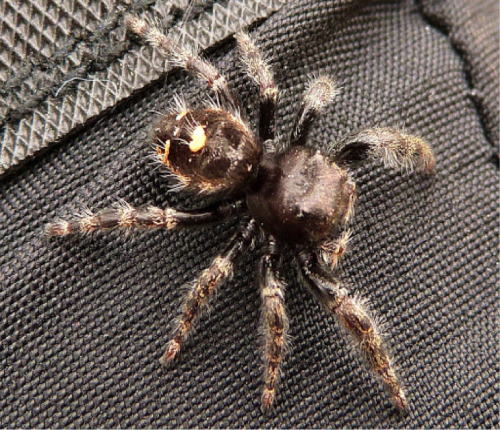Spider Bites
About This Disease
There are many species of spiders known to be found throughout Hawaii. Spiders typically live in crevices, rotten wood, gardens, and forest environments. Very few species are known to bite or cause harm to people as they generally feed on insects and other invertebrates. Many spiders are actually very important to our environment and island ecosystem.
However, two spider species of concern that are seen in Hawaii are the Southern Black Widow (Latrodectus mactans) and the Brown Widow Spider (Latrodectus geometricus). Their bites can be dangerous and would require a visit to the doctor. The brown widow is a little smaller than the black widow and its venom is twice as potent as the black widow’s venom. However, the brown widows don’t inject as much venom and are generally less aggressive in defending their webs.

Black Widow spider. Photo Credit: University of Missouri
Another spider of concern that is seen on the islands is the Bold or Daring Jumping Spider (Phidippus audax), which measures only a half inch in size. It might look harmless, but its bite is painful and may produce redness, swelling and blistering.

Daring Jumping spider. Photo Credit: Noah’s Project
The Brown recluse spider, a dangerous spider commonly found on the mainland, has not been documented as an established inhabitant of the Hawaiian Islands.
Signs and Symptoms
Symptoms associated with spider bites can vary from mild or unnoticeable to relatively severe. Very rarely, complications or even death can occur following severe bites. Symptoms of a typical spider bite can include;
- Itching or rash
- Pain radiating from the site of the bite
- Muscle pain or cramping
- Reddish to purplish color or blister
- Increased sweating
- Difficulty breathing
- Headache
- Nausea and vomiting
- Fever
- Chills
- Anxiety or restlessness
- High blood pressure
Transmission
Spider bites may occur when humans come into direct contact with spiders when working in the garden, outdoors and around the home.
Diagnosis
Diagnosis of spider bite is based on recent history and signs and symptoms. Specific diagnosis may be difficult to confirm without identification of the spider. Confirmation requires identification of the spider, evaluation of bite area, and exclusion of other possible sources of insect bites or injuries.
Treatment
If bitten by a spider, individuals should take the following steps:
- Stay calm. Identify the type of spider if it is possible to do so safely. Identification will aid in medical treatment.
- Wash the bite area with soap and water.
- Apply a cloth dampened with cold water or filled with ice to the bite area to reduce swelling.
- Elevate bite area if possible.
- Do not attempt to remove venom.
- Immediately seek professional medical attention.
- A tetanus booster may be recommended if you haven’t had one in the past 5 years.
Risk in Hawaii
Though rare, spider bites do occur. Your risk of being bitten increases if you live in areas where there is clutter and debris or if their habitat has been disturbed. Widow spiders prefer warm climates and dark, dry places.
Prevention
To reduce your exposure to potentially dangerous spiders:
- Remove spider webs from around your home.
- Seal any cracks or openings around your home and install window screens.
- Wear protective clothing such as long covered sleeves, long pants, hats, gloves and boots when handling piles of materials, lumber, rocks, etc.
- Eliminate tall grasses and reduce debris and rubble from outdoor work areas.
- Inspect and shake out clothing and shoes before getting dressed.
Additional Resources
Information for Clinicians
Last reviewed: July 21, 2022
